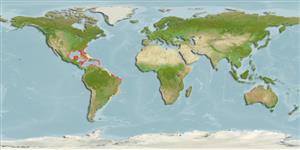Common names from other countries
Environment: milieu / climate zone / depth range / distribution range
Ecologie
Rifbewoner; brakwater; diepteverspreiding 2 - 76 m (Ref. 108813). Tropical
Western Atlantic: Caribbean and Gulf of Mexico.
Length at first maturity / Size / Gewicht / Leeftijd
Maturity: Lm ? range ? - ? cm Max length : 5.0 cm OT mannelijk/geslacht niet bekend; (Ref. 415)
Thick encrusting; 1 - 5 cm to massive amorphous. Black to dark brown or tan externally on parts unexposed to light, tan internally. Tough, firm, and cartilaginous (Ref. 415).
Maximum thickness: 5 cm (Ref. 415). Occasionally found on mangrove roots and peat banks. Common on reefs and lagoons (Ref. 415). Found on rocky substrates (Ref. 83912). Inhabits seagrasses, mangroves, coralline algae reefs, algal nodules, lower mesophotic and heavily silted reefs (Ref. 128739).
Life cycle and mating behavior
Geslachtsrijpheid | Voortplanting | Kuitschieten | Eieren | Fecundity | Larven
Members of the class Demospongiae are hermaphroditic. Life cycle: The zygote develops into parenchymella larva (free-swimming) before settling down on a substrate where it grows into a young sponge.
Collin, R., M.C. Díaz, J. Norenburg, R.M. Rocha, J.A. Sánchez, M. Schulze, A. Schwartz and A. Valdés. 2005. (Ref. 415)
Status op de Rode Lijst van het IUCN (Ref. 130435)
Status bij CITES (Ref. 108899)
Not Evaluated
Not Evaluated
Gebruik door de mens
| FishSource |
Tools
Meer informatie
Leeftijd/GrootteGroeiLengte-gewicht parametersLengte-lengte parametersMorfologieLarvenAbundantie
Internet-bronnen
Estimates based on models
Preferred temperature
(Ref.
115969): 23 - 28, mean 26.1 (based on 296 cells).
Kwetsbaarheid
Low vulnerability (10 of 100).
Prijsklasse
Unknown.
